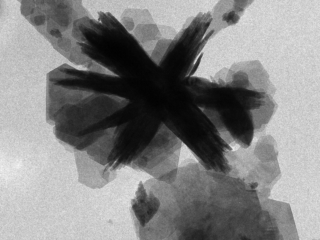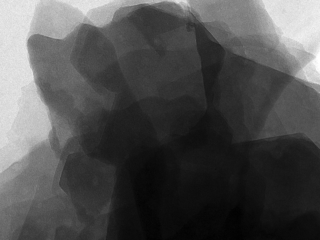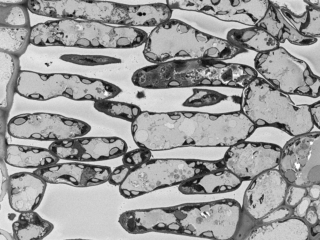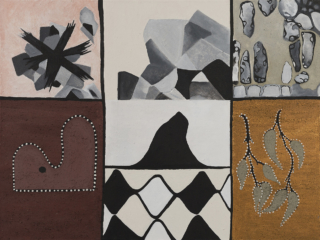Red ochre (badal in Gija)Red ochre (badal in Gija) showing the overlapping plate-like structure of the clays in the ochre and the star-shaped nanocrystals of iron oxide that give the red colour to the ochre. In some parts of the country red ochre occurs naturally. In others, it needs to be produced by baking yellow ochre. Baking drives off water molecules bound up in the yellow ochre form of iron oxide and turns it into the red form. The ‘star’ is around 750 nanometres across (1 nanometre is one millionth of a millimetre). Image: Hongwei Liu White ochre (mawurntu in Gija)White ochre is also known as kaolin and china clay. The flat plates of the white ochre give this pigment its smooth and slippery feel. Gija ancestors used white ochre as a disguise when hunting native animals – painting their bodies so that they could not be seen. The ochre also prevents the odour of the body’s sweat from being smelled by the prey, helping the tracker get close enough to kill the animal. Kaolin is often used instead of talc to make modern body powders. The area in this image is 520 nanometres across (1 nanometre is one millionth of a millimetre). Image by Hongwei Liu River Red Gum Leaf (mawurntu in Gija)The dome-shaped chloroplasts that line these leaf cells capture the sun’s energy to make sugars. These are stored as the white starch granules you can see inside the chloroplasts. That starch will help to fuel the growth of these magnificent trees. Some trees could be as old as 1000 years. River red gums live along water courses throughout Australia and play an essential role in Aboriginal life. River red gum leaves are used for smoking ceremonies (mantha in Gija) when welcoming new visitors on country. They can be used as a bush medicine, treating sores, colds and the flu. The area in this image is 108 micrometres across (1 micrometre is one thousandth of a millimetre). Image: Minh Huynh, Elinor Goodman and Margaret Barbour |
Badel, Mawundu & GoorndooljiIn this artwork there are a total of six squares but the top three are all representations of different materials and what they look Artist: April Nulgit |






